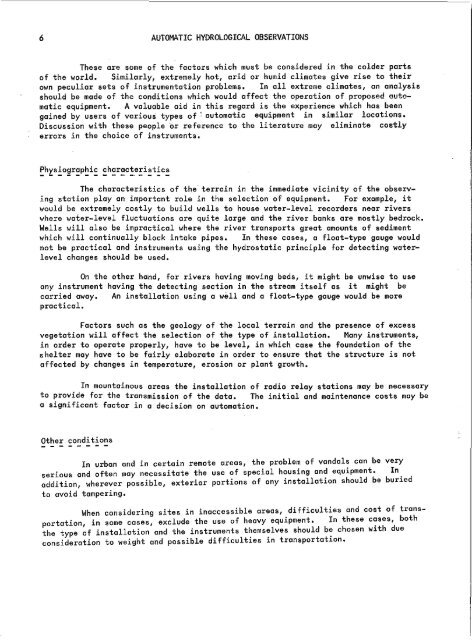automatic collection and transmission of ... - E-Library - WMO
automatic collection and transmission of ... - E-Library - WMO
automatic collection and transmission of ... - E-Library - WMO
You also want an ePaper? Increase the reach of your titles
YUMPU automatically turns print PDFs into web optimized ePapers that Google loves.
6 AUTOMATIC HYDROLOGICAL OBSERVATIONSThese are same <strong>of</strong> the factors which must be considered in the colder parts<strong>of</strong> the world. Similarly, extremely hot, arid or humid climates give rise to theirown peculiar sets <strong>of</strong> instrumentation problems. In all extreme climotes, on analysisshould be mode <strong>of</strong> the conditions which would affect the operation <strong>of</strong> proposed outomaticequipment. A valuable aid in this regard is the experience which has beengained by users <strong>of</strong> various types <strong>of</strong> : <strong>automatic</strong> equipment in similar location••Discussion with these people or reference to the literature may eliminate costlyerrors in the choice <strong>of</strong> instruments.The characteristics <strong>of</strong> the terrain in the immediote vicinity <strong>of</strong> the observingstation play an important role in the selection <strong>of</strong> equipment. For example, itwould be extremely costly to build wells to house water-level recorders near riverswhere waier-level fluctuations are quite large <strong>and</strong> the river banks are mostly bedrock.Wells will also be impractical where the river transports great amounts <strong>of</strong> sedimentwhich will continually block intake pipes. In these cases, a float-type gauge wouldnot be practical <strong>and</strong> instruments using the hydrostatic principle for detecting waterlevelchonges should be used.On the other h<strong>and</strong>, for rivers having moving beds, it mightany instrument having the detecting section in the stream itself ascarried away. An installation using a well <strong>and</strong> a float-type gaugepractical.be unwise to useit might bewould be moreFactors such as the geology <strong>of</strong> the local terrain <strong>and</strong> the presence <strong>of</strong> excessvegetation will affect the selection <strong>of</strong> the type <strong>of</strong> installation. Many instruments,in order to operate properly, have to be level, in which case the foundation <strong>of</strong> theshelter may have to be foirly elaborate in order to ensure that the structure is notaffected by changes in temperature, erosion or plant growth.In mountainous areas the installation <strong>of</strong> radio relay stations may be necessaryto provide for the <strong>transmission</strong> <strong>of</strong> the data. The initial <strong>and</strong> mointenance costs may bea significant factor in a decision on automation.Other conditionsIn urban <strong>and</strong> in certain remote areas, the problem <strong>of</strong> v<strong>and</strong>als can beserious <strong>and</strong> <strong>of</strong>ten may necessitate the use <strong>of</strong> special housing <strong>and</strong> equipment.addition, wherever possible, exterior portions <strong>of</strong> any installation should beto avoid tampering.veryInburiedWhen considering sites in inaccessible areas, difficulties <strong>and</strong> cost <strong>of</strong> transportation,in some cases, exclude the use <strong>of</strong> heavy equipment. In these c~ses, boththe type <strong>of</strong> installation <strong>and</strong> the instruments themselves should b: chosen w~th dueconsideration to weight <strong>and</strong> possible difficulties in tronsportat~on.
















